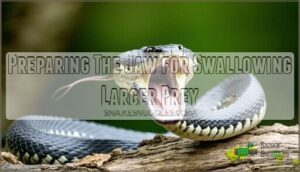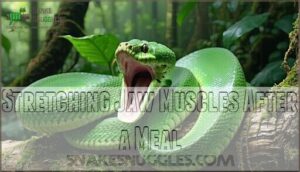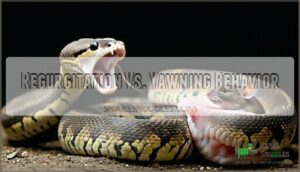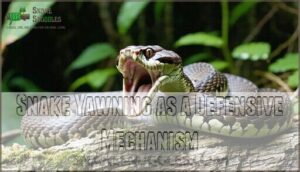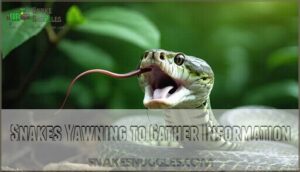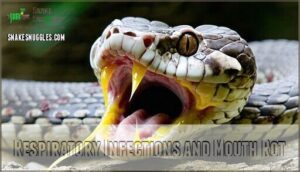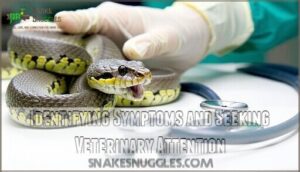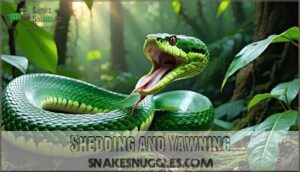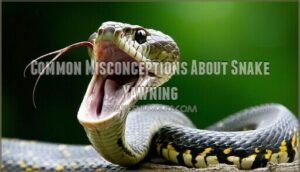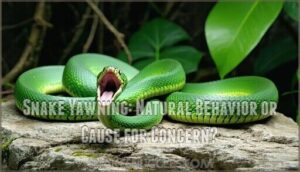This site is supported by our readers. We may earn a commission, at no cost to you, if you purchase through links.
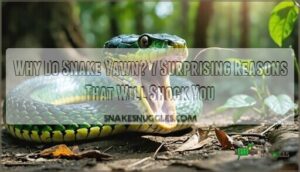
You’ll also find a bit of detective work going on, as a snake enhances its sense of smell to map out the world.
Sometimes, yawning helps shed old skin or signals health issues. So, when you wonder "why do snakes yawn?" know that it’s all about survival, comfort, and the occasional bit of snake drama—there’s more than meets the eye.
Table Of Contents
- Key Takeaways
- The Purpose of Snake Yawning
- Snake Yawning and Digestion
- Snake Yawning as a Defensive Mechanism
- Snakes Yawning to Gather Information
- Yawning as a Sign of Health Issues
- Shedding and Yawning
- Common Misconceptions About Snake Yawning
- Snake Yawning: Natural Behavior or Cause for Concern?
- Frequently Asked Questions (FAQs)
- Are all snakes poisonous?
- How can you tell the difference between a poisonous and non-poisonous snake?
- What do you do if you see a snake?
- How can you tell if a snake is dangerous?
- Who is the author of this article and what is their background?
- Can snake yawning be influenced by changes in lighting?
- Do captive snakes yawn differently than wild snakes?
- Are certain snake species more prone to yawning?
- How does temperature affect yawning frequency in snakes?
- Is snake yawning linked to hydration or dehydration?
- Conclusion
Key Takeaways
- You’ll see snakes yawn to realign their jaws after eating, making it easier for them to swallow big meals.
- When a snake yawns at you, it can be sending a warning or trying to look more threatening to stay safe.
- Yawning helps snakes “taste” the air, boosting their sense of smell and letting them size up their environment.
- Frequent, prolonged yawning can signal health issues like respiratory infections, so keep an eye out for other unusual signs.
The Purpose of Snake Yawning
You’ll discover that snake yawning isn’t just a simple stretch but fills three important biological functions that keep these reptiles alive and thriving.
When you observe a snake opening its mouth wide, it’s actually performing jaw realignment after feeding, sending warning signals to potential threats, or gathering key environmental information through enhanced chemoreception.
Jaw Realignment for Eating
Ever wonder how snakes manage post-meal alignment after swallowing enormous prey? Snake yawning functions as nature’s jaw adjustment mechanism, resetting mandible position through ligament flexibility. This swallowing mechanics marvel helps achieve jaw comfort after stretching.
So, what exactly goes on when a snake resets its jaw?
- Elastic ligaments reconnect upper and lower jaw sections
- Mandible resetting restores normal jaw positioning
- Jaw stretching relieves tension from prey ingestion
This jaw adjustment process ensures your snake’s comfort after eating.
Communication and Warning Signals
When you spot a snake opening its mouth wide, you’re witnessing defensive yawning behavior in action. This threat display acts as a warning signal to potential predators or threats. Defensive display patterns help snakes communicate their readiness to strike without actually attacking.
Environmental cues trigger these stress indicators, signaling danger nearby. Social signaling through defensive behavior and yawning creates distance between the snake and perceived threats. This threat response mechanism proves highly effective for survival.
Gathering Environmental Information
Beyond warning signals, you’ll notice snakes yawning to collect key environmental data through their chemoreception system. This behavior enhances scent particle collection, drawing airflow across their vomeronasal organ function for enhanced environmental sensing. Think of it as nature’s chemical detective work—snakes literally taste the air to understand their surroundings.
Here’s what actually happens when a snake yawns to sense its environment:
- Airflow chemoreception – Increased air movement carries more chemical molecules to sensory receptors
- Vomeronasal organ activation – Specialized cells process scent particles for threat detection
- Enhanced sensory perception – Multiple chemical signatures reveal prey, predators, and territorial boundaries
- Snake chemoreception system integration – Combined input from tongue-flicking and yawning creates thorough environmental maps
Snake Yawning and Digestion
When you watch a snake yawn, you’re witnessing an important digestive process that’s far more complex than it appears.
Your snake’s jaw realignment and muscle stretching aren’t just random behaviors—they’re essential preparation and recovery steps that allow these impressive predators to consume prey much larger than their head size.
Preparing The Jaw for Swallowing Larger Prey
When you watch your snake yawn before feeding time, you’re witnessing jaw preparation in action. Snake yawning stretches jaw ligaments and adjusts mandible movement for best prey ingestion.
This jaw flexibility allows swallowing mechanics to accommodate prey size often larger than the snake’s head diameter. Jaw realignment through yawning ensures proper jaw mechanics function smoothly during the feeding process.
Stretching Jaw Muscles After a Meal
When a snake yawns after eating, it’s actually giving its jaw a well-deserved stretch—think of it like a post-workout cool-down. After managing to swallow prey whole, those flexible ligaments and hardworking muscles need realignment so everything moves comfortably again.
Resetting the jaw in this way means less muscle tension and more flexibility, helping the ligaments bounce back from being stretched so wide. It also gets the jaw bones back where they belong, which is crucial for a comfortable bite next time.
Essentially, this behavior means your snake is keeping its jaws limber and ready for whatever comes next, while also steering clear of any lingering stiffness.
Regurgitation Vs. Yawning Behavior
Many snake owners confuse regurgitation with normal yawning behavior, but understanding these digestive differences can save your pet’s life. Regurgitation is often caused by stress indicators such as handling or cold temperatures, whereas yawning can be triggered by the need for jaw realignment after feeding. Ball pythons may also yawn to utilize their Jacobson’s organ for environmental awareness.
| Regurgitation | Yawning |
|---|---|
| Expels undigested food | No food ejection |
| Life-threatening trauma | Harmless jaw reset |
| Requires veterinary care | Self-resolving behavior |
Snake feeding habits demonstrate that there is some behavioral overlap between regurgitation and yawning. However, it is crucial to recognize that regurgitation demands immediate attention, while mouth gaping during normal yawning is a sign of healthy digestive adjustment.
Snake Yawning as a Defensive Mechanism
When you encounter a snake with its mouth wide open, you’re likely witnessing a defensive display designed to make the animal appear larger and more threatening to potential predators. This intimidation tactic, combined with specific body postures like coiling or rearing up, acts as the snake’s first line of defense before resorting to striking or fleeing.
Displaying Warning Signs to Deter Predators
When you see a snake yawn, it’s not sleepy—it’s showing off its impressive defensive arsenal. This defensive yawning behavior functions as predator deterrence, basically saying "back off" without words.
Through defensive posturing, snakes create threat signals that warn potential attackers about their strike preparation capabilities. This behavioral ecology adaptation helps with predator avoidance by displaying their fangs and gaping mouth as a defensive display.
It’s nature’s way of advertising danger—a clear threat response and warning signal system.
Defensive Positions and Gestures
Beyond deterring threats through warning signals, you’ll notice snakes use specific defensive stances that make their threat displays even more effective. When threatened, they’ll arch their necks and raise their heads to appear larger while opening their mouths wide in defensive yawning behavior. This body language creates an impressive warning signal that screams "back off" to potential predators.
Here are three key defensive gestures snakes use:
- Striking posture – Coiled body with head raised and mouth agape
- Threat response positioning – S-shaped neck curve for greatest reach
- Aggressive behavior displays – Hissing combined with defensive display yawning
This predator avoidance strategy works like a charm most of the time.
Snakes show off their defensive side with a few signature moves:
Human Encounters and Snake Behavior
When you encounter snakes in urban environments, their yawning often signals defensive behavior rather than sleepiness. This threat response helps snakes communicate discomfort during human interactions. Understanding snake behavior patterns improves coexistence strategies and reduces aggressive encounters.
| Encounter Type | Snake’s Yawning Response | Your Best Action |
|---|---|---|
| Backyard Discovery | Defensive gaping display | Maintain distance, allow escape route |
| Trail Hiking | Warning posture with yawning | Back away slowly, avoid sudden movements |
| Home Invasion | Stress-induced mouth opening | Contact wildlife removal professionals |
| Garden Work | Territorial threat display | Use safe handling practices, wear protection |
Proper conservation education teaches us that snakebite first aid knowledge matters less than prevention through respectful observation.
Snakes Yawning to Gather Information
You’ll be amazed to learn that when snakes yawn, they’re actually using their mouths like well-developed chemical sensors to analyze their environment.
This behavior enhances scent particle collection through their vomeronasal organ, allowing them to gather detailed information about prey, predators, and territory through what scientists call "stereo smelling."
The Role of The Vomeronasal Organ
When you observe a snake yawning, it’s activating its vomeronasal organ (VNO) or Jacobson’s organ for enhanced chemoreception. This specialized sensory system processes chemical signals collected through tongue flicking, enabling precise scent tracking and prey detection. Snake yawning aids airflow that helps transport scent particles to this special organ, boosting their snake sensory perception capabilities.
- Chemical detective work: The VNO analyzes molecular information from the environment
- Prey tracking advantage: Enhanced scent detection helps locate potential meals
- Environmental mapping: Chemical signals provide detailed habitat information
Stereo Smelling and Independent Nostrils
Snake nostril-independence creates a next-level scent-localization system that’ll blow your mind. Each nostril operates separately, allowing precise chemoreception and enhanced vomeronasal input.
When you watch a snake yawn, it’s optimizing sensory perception by exposing Jacobson’s organ to airborne molecules. This olfactory acuity helps snakes triangulate scent sources with impressive precision.
The vomeronasal organ processes chemical signals independently from each nostril, creating stereo-smelling capabilities. This snake sensory perception system transforms their sense of smell into a three-dimensional mapping tool for survival.
Yawning as a Sign of Health Issues
If you notice your snake yawning excessively or keeping its mouth open for extended periods, it’s not just stretching—it could signal respiratory infections or mouth rot.
These health conditions cause compensatory gaping behaviors as your snake struggles with breathing difficulties or oral discomfort, making prompt veterinary attention essential.
Respiratory Infections and Mouth Rot
When your snake’s information-gathering turns into excessive gaping, you’re witnessing potential snake illness. Respiratory infections and mouth rot cause persistent open-mouth behavior that mimics yawning.
Watch for these infection symptoms:
- Increased mucus production and nasal discharge
- Yellow pus or swelling in oral cavity
- Loss of appetite with lethargy
If your snake keeps opening its mouth for long stretches—almost like it’s yawning—this can be a warning sign that something’s wrong. Respiratory infections and mouth rot often cause this kind of gaping.
Some common signs of infection:
- Extra mucus or runny discharge from the nose
- Swelling or yellowish buildup in the mouth
- Tiredness and little interest in food
A quick trip to the vet is your best move for antibiotics and care. Doing your part at home—like keeping things clean and the habitat healthy—can help prevent most of these problems.
Respiratory diseases create a domino effect where your pet struggles for every breath. Veterinary intervention becomes necessary when open-mouth breathing persists beyond feeding time.
Identifying Symptoms and Seeking Veterinary Attention
When respiratory difficulties persist, you’ll need professional help. Watch for these warning signs that require a vet appointment:
- Abnormal gaping with wheezing sounds
- Oral discharge or thick mucus buildup
- Lethargy signs combined with breathing troubles
- Snake yawning excessively without feeding context
If your snake keeps struggling to breathe, it’s time to call in a professional. Keep an eye out for these signs that mean your vet should take a look:
Shedding and Yawning
You’ll notice your snake yawning more frequently during its shedding cycle, and there’s a fascinating reason behind this behavior.
The tight, old skin around the jaw area creates discomfort that triggers compensatory mouth movements, helping your snake stretch and loosen the restrictive skin layers before they’re ready to shed completely.
The Shedding Process in Snakes
Beyond health concerns, you’ll notice behavioral changes when your snake gets ready for ecdysis. Shedding frequency varies by species and age, with younger snakes molting more often. The process unfolds in distinct stages: skin becomes dull and opaque, then your snake rubs against surfaces to begin splitting the old layer. This creates ecdysis difficulties if skin hydration isn’t adequate.
Key shedding indicators include:
- Milky, clouded eyes that clear before molting
- Reduced appetite and increased hiding behavior
- Restless movement and frequent rubbing against objects
- Skin elasticity changes making scales appear stretched
- Dull, faded coloration throughout the body
- Increased sensitivity to handling and environmental changes
- Post-shed care requirements including humidity monitoring
Snake yawning often increases during this vulnerable period as stress mounts.
Yawning During The Shedding Stages
During ecdysis assistance, you’ll notice increased snake yawning as shedding stress builds. This behavior helps maintain skin flexibility and takes care of lubrication needs around the jaw area.
Yawning and shedding skin work together – the stretching motion promotes skin elasticity during this vulnerable period. Post-shed realignment becomes essential as snakes adjust to their refreshed exterior coating.
Removing Old and Uncomfortable Skin
How does snake yawning help with the shedding process? During ecdysis, your snake’s old skin becomes tight and uncomfortable, especially around the head and mouth areas.
Snake yawning creates important jaw stretching that helps loosen retained shed from facial structures. This mouth-gaping behavior works like natural lubrication methods, allowing skin elasticity to work more effectively.
The shedding frequency varies by species, but yawning consistently aids the shedding process when ecdysis difficulties arise. Poor husbandry influence can complicate yawning and shedding skin coordination, making this behavior even more important for successful molts.
Common Misconceptions About Snake Yawning
You’ve probably heard that snakes "unhinge" their jaws when they yawn, but this isn’t technically accurate. Snake jaws don’t actually disconnect – instead, they use highly elastic ligaments and specialized joint structures that allow considerable flexibility without true unhinging.
Myth of Unhinging Jaws
Plenty of folks fall for the Jaw Dislocation Myth, but snakes don’t actually unhinge anything. Here’s what’s really going on:
- Mandible Flexibility allows each side to move independently.
- Elastic ligaments hold things together, not magic.
- Skull anatomy allows for jaw adjustment.
- Swallowing big prey triggers jaw realignment.
- Jaw stretching is all about mechanics, not dislocation.
Elasticity and Adaptability of Snake Jaws
Forget what you’ve heard about snakes “unhinging” their jaws—instead, it’s all about jaw ligament flexibility and cranial kinesis. Thanks to adaptable mandibular bone structure and elastic ligaments, a snake’s jaw mechanics allow for easy jaw adjustment and stretching.
This evolutionary jaw change means they can handle massive meals with:
- Prey size adaptation
- Jaw realignment
- Jaw muscle flexibility
- Efficient jaw stretching
That shift in their jaw structure lets snakes tackle huge prey thanks to:
Clarifying Misconceptions and Understanding Snake Behavior
Let’s clear the air about snake yawning. For one, Snake Jaw Myths are everywhere—snakes don’t “unhinge” their jaws like a cartoon. Instead, those jaws are built with stretchy ligaments and segments that slide side-to-side, helping with Behavioral Interpretations you mightn’t expect.
Yawning isn’t random; it’s a legit Calming Signal, letting snakes reset their jaw after a big meal or deal with Stress Indicators—kind of like a relaxing stretch for us. There are also Species Variations in Snake yawning behavior patterns, so what’s normal for one Reptile may not be for another.
Knowing these reasons for snake yawning gives you real insight into Snake behavior.
Snake Yawning: Natural Behavior or Cause for Concern?
Let’s clear up some snake yawning confusion. First off, forget that old cartoon idea—snakes don’t actually "unhinge" their jaws.
Instead, their jaws are connected by flexible ligaments and can slide sideways, which helps them do things you might not expect.
You might catch your snake giving an impressively theatrical yawn and wonder if it’s just stretching or signaling a problem. While this behavior usually helps realign the jaw, you’ll want to understand when those wide-mouthed moments could suggest an underlying health issue.
Normal Frequency and Context of Yawning
In reptile behavior, recognizing normal yawning means tuning into a snake’s routine. You’ll see yawns pop up before dinner, after a big meal, or when the weather shifts. Key factors affecting snake yawning behavior patterns include:
- Species Variation
- Age Influence
- Environmental Impact
- Individual Habits
Just as you might stretch after a nap, snakes yawn in response to their unique animal behavior cues.
Signs of Distress or Illness to Watch For
Anyone’s snake can toss out a yawn now and then, but keep an eye out for labored breathing, lethargy signs, unusual posturing, or eating changes.
These can flag issues like respiratory infections, mouth rot, or respiratory distress. Wheezing, discharge, or refusing food? Time for a veterinary consultation.
Quick action beats waiting—snakes don’t fake being ill.
Addressing Excessive Yawning and Seeking Professional Advice
Now and then, a snake’s yawning catches you off guard. Here’s how to respond when excessive gaping raises eyebrows:
- Schedule a veterinarian consultation for expert diagnostic procedures.
- Monitor yawning patterns and context.
- Watch for signs like respiratory infections or mouth rot before seeking a reptile vet.
- Evaluate enclosure and husbandry.
Sometimes you’ll notice your snake opening its mouth wide—it can be surprising! If your snake is yawning more than usual and it has you wondering if something’s up, here’s what to do:
Frequently Asked Questions (FAQs)
Are all snakes poisonous?
Think of snakes as a mixed bag of jelly beans—most are harmless, but only a minority are venomous, not poisonous. You might meet a gentle corn snake, so don’t expect every slither to pack a punch.
How can you tell the difference between a poisonous and non-poisonous snake?
If you spot a triangular head, vertical pupils, or heat-sensing pits, you might be dealing with a venomous snake.
Don’t rely on color alone—many harmless snakes mimic their venomous cousins just to keep things interesting!
What do you do if you see a snake?
If you see a snake, freeze—don’t try your best Indiana Jones impression. Back away slowly, give it space, and don’t poke or prod. Most snakes want nothing to do with humans and will move along.
How can you tell if a snake is dangerous?
Watch for triangular heads, slit-shaped pupils, rattles, and bold patterns. If it hisses, coils, or stands its ground, back away—some snakes are just drama queens, but better safe than sorry!
Who is the author of this article and what is their background?
Picture a Nobel laureate moonlighting as your snake-savvy neighbor: the author’s a seasoned animal behaviorist blending sharp research skills, technical know-how, and friendly storytelling that turns herpetology into a backyard barbecue conversation you’ll never forget.
Can snake yawning be influenced by changes in lighting?
You mightn’t think a snake needs mood lighting, but changes in lighting really can influence yawning.
Shifts in brightness cue your snake to adjust body rhythms, sometimes triggering yawning as a way to recalibrate.
Do captive snakes yawn differently than wild snakes?
You’ll notice captive snakes often yawn more than wild ones due to less environmental variety and more handling.
It’s like stretching after a nap—sometimes a habit, sometimes a sign they’re adjusting to their surroundings.
Are certain snake species more prone to yawning?
Snakes don’t yawn like drama queens, but species like boas and pythons do stretch their jaws more often due to their eating habits. You’ll spot these routine jaw resets, especially after a hefty meal or before hunting.
How does temperature affect yawning frequency in snakes?
When it gets chilly, you’ll likely notice your snake yawning more often, as temperature dips can stress them out.
Warm temps encourage normal breathing, while colder conditions sometimes make those jaw stretches pop up more frequently.
Is snake yawning linked to hydration or dehydration?
You won’t find much evidence linking a snake’s yawn to thirst or dehydration.
This quirky mouth stretch is more about jaw alignment and respiration than water balance—so you can’t use it to judge hydration levels.
Conclusion
Much like a mystery novel with plenty of twists, why do snakes yawn? It’s rarely just one reason.
You’ve seen how snakes yawn to realign jaws, prep for dinner, warn off intruders, and pick up scents. Sometimes, it even signals health issues or helps with shedding.
Keep an observant eye—yawning is a normal, multi-purpose behavior, but if you spot repeated yawns paired with odd symptoms, a reptile vet should be your next detective.
- https://www.wildcreatureshongkong.org/single-post/2019/12/16/why-do-snakes-yawn
- https://www.pettalkdaily.com/blog/why-do-snakes-yawn
- https://a-z-animals.com/blog/why-snakes-yawn/
- https://ball-pythons.net/forums/showthread.php?44483-How-often-do-your-balls-quot-Yawn-quot
- https://en.wikipedia.org/wiki/Yawn

